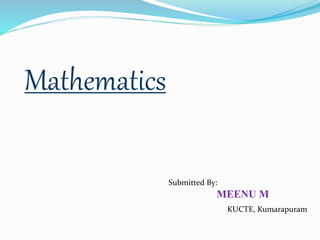Powers
•Download as PPTX, PDF•
0 likes•151 views
The document discusses powers of negative numbers. Some key points are: 1) The even powers of -2 are equal to the same power of 2, while the odd powers of -2 are the negative of the same power of 2. 2) The powers of -1 follow a pattern of (-1)1 = -1, (-1)2 = 1, (-1)3 = -1, and so on. 3) To write fractions like 42/45, we define negative powers using a new meaning - that x(-n) = 1/xn, to allow expressions like 4(-3) to have meaning as 1/43.
Report
Share
Report
Share

Recommended
Three dimensional 3D Presentation

3-dimensional definition,
what is 3d definition,
what is 3d image,
3d definition in art,
three-dimensional objects,
what is 3d technology,
what is 3d movie,
3-dimensional figures,
Three Dimensional(3D)
Ideal Bose Systems

In a world where Einstein’s relativity is true, space has three dimensions, and there is quantum mechanics, all particles must be either fermions or bosons. This statement is a mathematical theorem, not an observation from data. But data over the past 100 years seems to bear it out; every known particle in the Standard Model is either a fermion or a boson.
An example of a boson is a photon. Two or more bosons (if they are of the same particle type) are allowed to do the same exact thing. For example, a laser is a machine for making large numbers of photons do exactly the same thing, giving a very bright light with a very precise color heading in a very definite direction. All the photons in that beam are in lockstep.
Something else you can do with boson particles is form a Bose-Einstein condensate, a phenomenon predicted by Einstein back in the 1920’s but only produced in a definitive way in the 1990’s, in Nobel-Prize winning experiments described in the link above. What these experiments do in making this condensate is cause large numbers of identical boson atoms to all sit as still as a quantum mechanical object possibly can.
In principle you could make something similar to a laser out of any boson. This has been done for atoms too. And even more recently, a Bose-Einstein condensate has been made out of photons.
In this Powerpoint show, you will become you can see proofs of equations of Pathria's Statistical mechanic, Chapter7.
Recommended
Three dimensional 3D Presentation

3-dimensional definition,
what is 3d definition,
what is 3d image,
3d definition in art,
three-dimensional objects,
what is 3d technology,
what is 3d movie,
3-dimensional figures,
Three Dimensional(3D)
Ideal Bose Systems

In a world where Einstein’s relativity is true, space has three dimensions, and there is quantum mechanics, all particles must be either fermions or bosons. This statement is a mathematical theorem, not an observation from data. But data over the past 100 years seems to bear it out; every known particle in the Standard Model is either a fermion or a boson.
An example of a boson is a photon. Two or more bosons (if they are of the same particle type) are allowed to do the same exact thing. For example, a laser is a machine for making large numbers of photons do exactly the same thing, giving a very bright light with a very precise color heading in a very definite direction. All the photons in that beam are in lockstep.
Something else you can do with boson particles is form a Bose-Einstein condensate, a phenomenon predicted by Einstein back in the 1920’s but only produced in a definitive way in the 1990’s, in Nobel-Prize winning experiments described in the link above. What these experiments do in making this condensate is cause large numbers of identical boson atoms to all sit as still as a quantum mechanical object possibly can.
In principle you could make something similar to a laser out of any boson. This has been done for atoms too. And even more recently, a Bose-Einstein condensate has been made out of photons.
In this Powerpoint show, you will become you can see proofs of equations of Pathria's Statistical mechanic, Chapter7.
ゲーム理論NEXT コア第4回(最終回) -平衡ゲームとコア-

https://www.nicovideo.jp/watch/sm37683676
https://www.youtube.com/watch?v=L2Hsb05ge4A&feature=youtu.be
More Related Content
What's hot
ゲーム理論NEXT コア第4回(最終回) -平衡ゲームとコア-

https://www.nicovideo.jp/watch/sm37683676
https://www.youtube.com/watch?v=L2Hsb05ge4A&feature=youtu.be
What's hot (15)
Powers
- 1. Mathematics Submitted By: MEENU M KUCTE, Kumarapuram
- 2. Standard: viii Unit: Negative Numbers
- 4. What are the powers of 2? 21 = 2 22 = 2*2 = 4 23 = 2*2*2 = 4*2 = 8 ……………………………………… …………………………………………………
- 5. What about the powers of (-2)? (-2)1 = (-2) (-2)2 = (-2)*(-2) = 4 (-2)3 = (-2)*(-2)*(-2) = 4*(-2) =(-8) ……………………………………… …………………………………………………
- 6. Thus every even power of (-2) is equal to the same power of 2; every odd power of (-2) is the negative of the same power of 2.
- 7. It is true for other number also… Isn’t it ? So what are the power of (-1)? (-1)1 = (-1) (-1)2 = 1 (-1)3 = (-1) ………………………………………
- 8. Now we can consider fraction… How can we write 45/42 45/42 = 45-2 = 43
- 9. How can we write 42/45 42/45 = 4(2-5) = 4(-3) According to our definition of powers, does 4(-3) have any meaning?
- 10. What is the meaning in saying , the product of (-3) fours? So we give a new meaning to negative powers, different from repeated multiplication.
- 11. If we want to get 42/45 = 4(2-5) = 4(-3), then we should define 4(-3) = 1/43
- 12. In general we make the following definition, for all x≠0 and for all natural number n x(-n) = 1/xn
- 13. We can combine two of the general principles on the quotients of powers to a single principles namely, xm/xn = xm-n whether m>n or m<n
- 14. Thank you